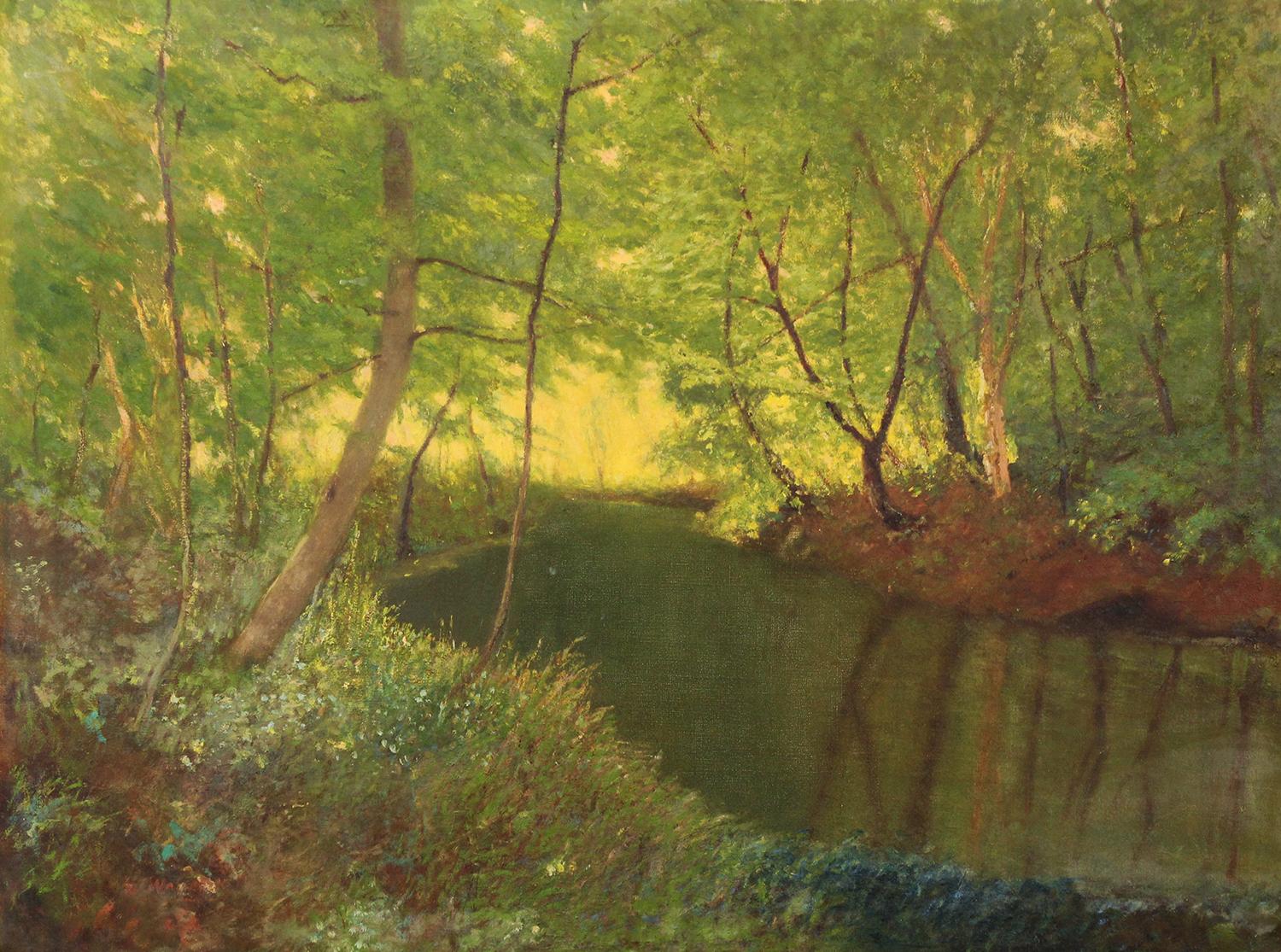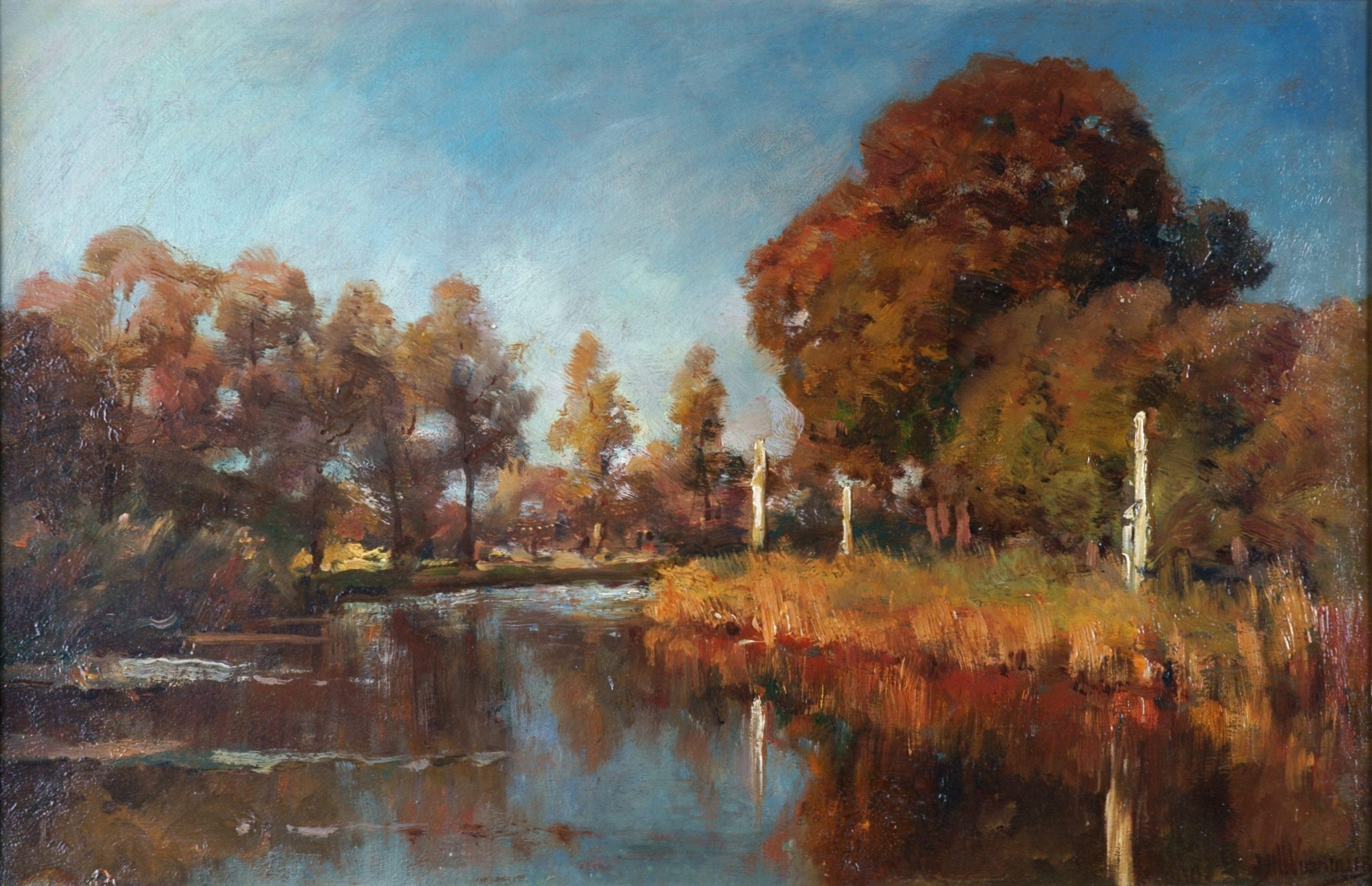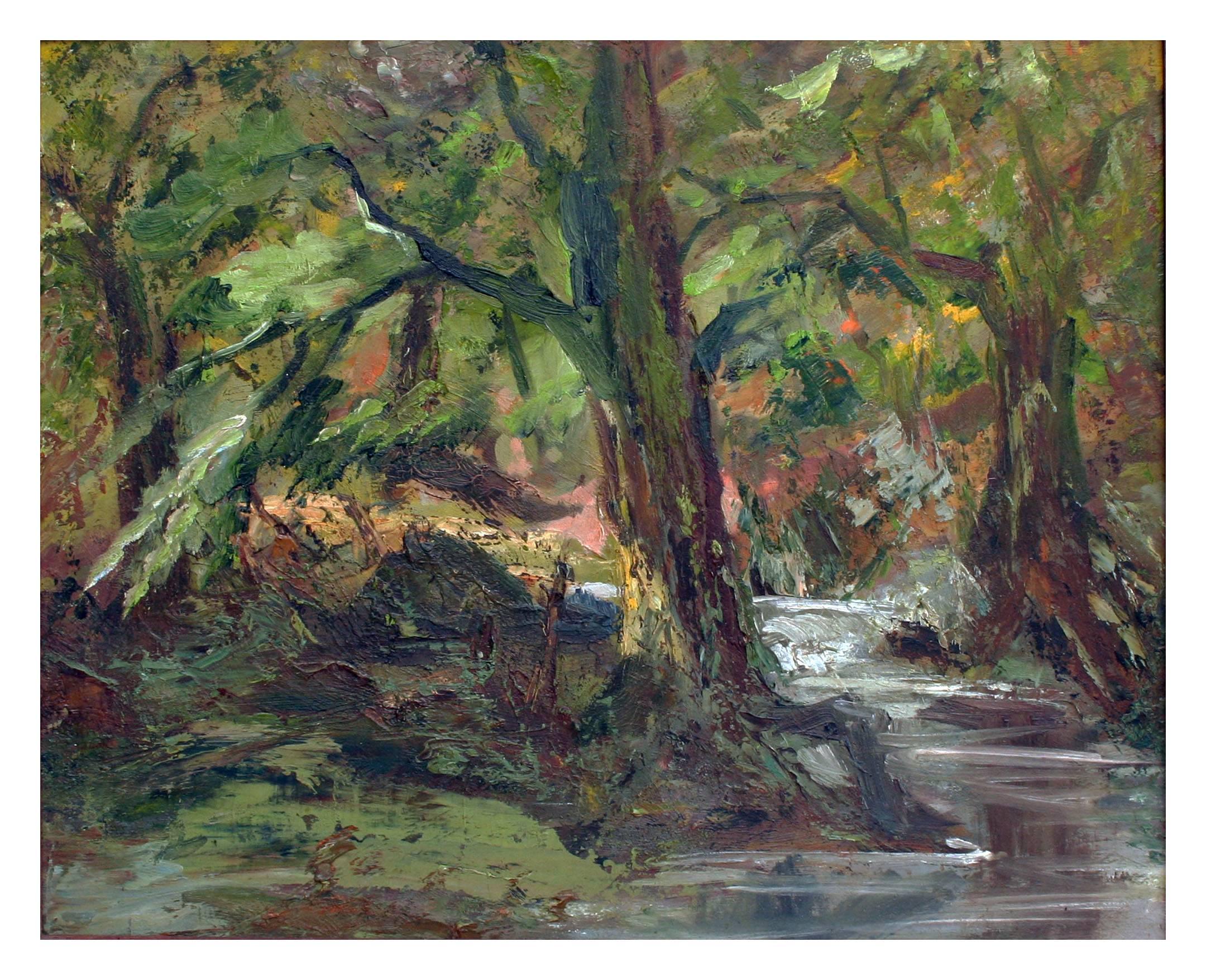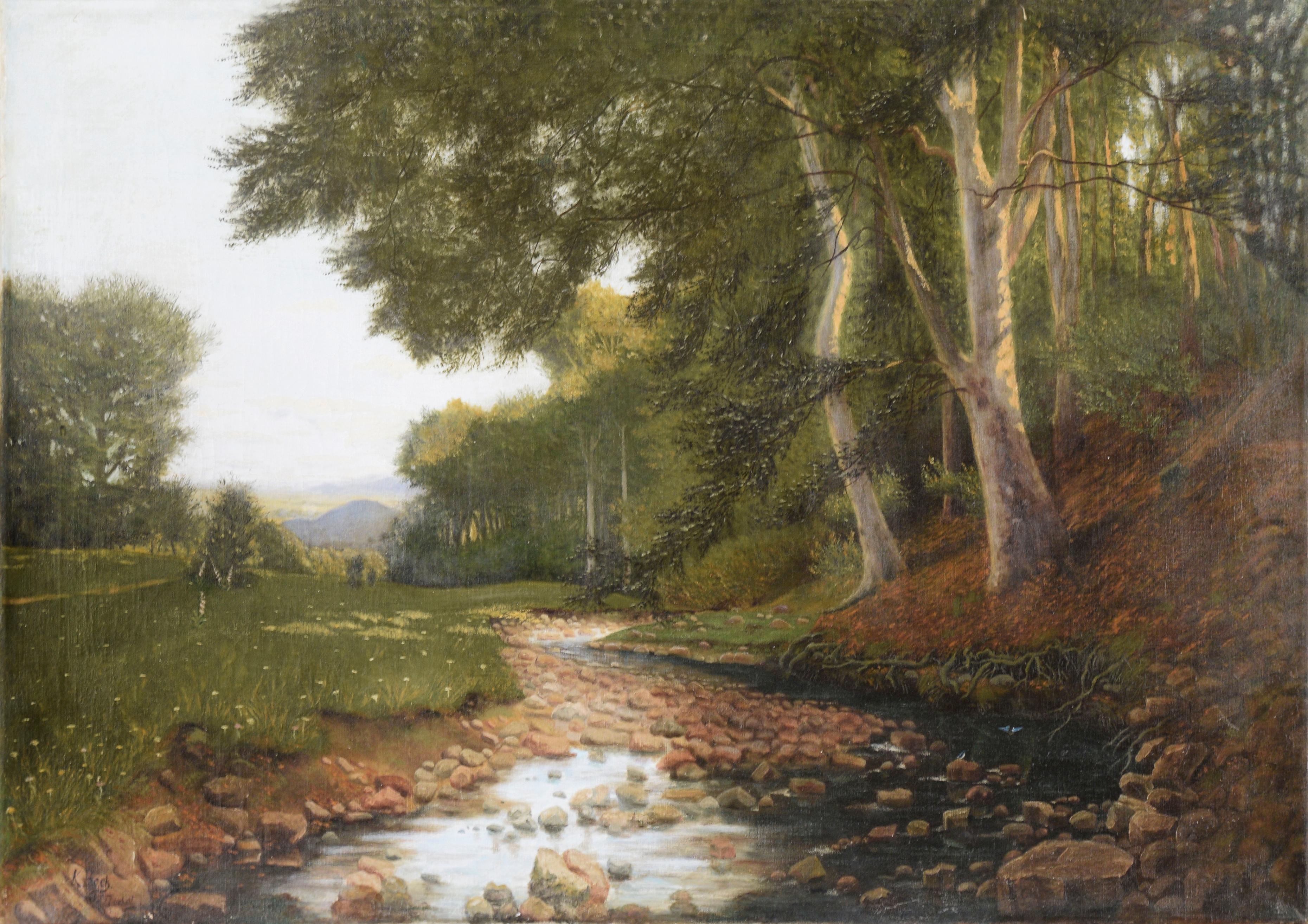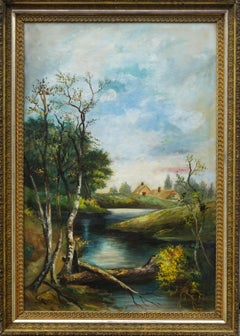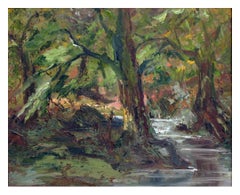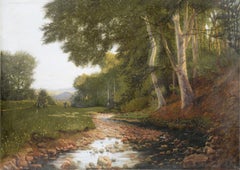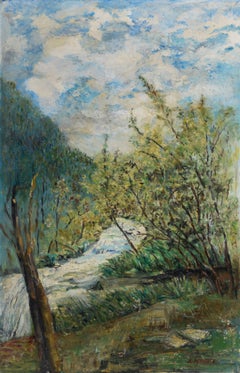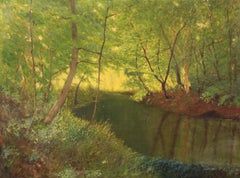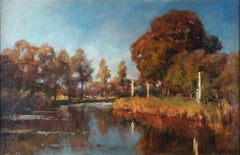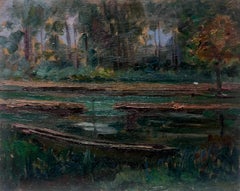Items Similar to Shady Stream - Late 19th Century Bucolic Landscape
Want more images or videos?
Request additional images or videos from the seller
1 of 13
Nikolai Aleksandrovich Sergeev (Sergeyev)Shady Stream - Late 19th Century Bucolic Landscape1890
1890
$12,375
$16,50025% Off
£9,344.27
£12,459.0325% Off
€10,841.28
€14,455.0325% Off
CA$17,390.76
CA$23,187.6825% Off
A$19,375.76
A$25,834.3525% Off
CHF 10,115.07
CHF 13,486.7525% Off
MX$235,247.60
MX$313,663.4725% Off
NOK 127,139.78
NOK 169,519.7025% Off
SEK 120,177.98
SEK 160,237.3025% Off
DKK 80,928.82
DKK 107,905.0925% Off
About the Item
Gorgeous late 19th Century Russian landscape with stream in the shade by Nikolai Aleksandrovich Sergeev (Nikolai Alexandrovich Sergeyev ) (Mykola Oleksandrovyc Serhjejev ) (Russian Empire, 1855-1919), 1890. Signed and dated in Cyrillic on front and his studio monogram stamp on verso and an attestation statement Translation: "Sketch of academician N.A. Sergeev, dates back to the early nineties (1890s) . Authenticity is evidenced by the son of artist Sergeev and the Sergeev stamp.
Unframed. Image size: 12"H x 18"W.
There are various ways of spelling or translating his name from the Russian: Nikolay Aleksandrovich Sergeyev or Nikolai Sergeev. He studied painting with the famous master and professor of the Academy of Arts LF Lagorio . The best works: "The stalled river", "June", "Elegy", "The cloud came up", "The wind gets stronger", "Steppe", "The stars are burning down", "Dnepr Bay" .
In 1889 he was awarded the Order of St. Stanislav 3rd degree in the promotion of activities in the artistic field.
In 1910, N. A. Sergeev became an academician of landscape painting.
References:
• S. N. Kondakov. Anniversary reference book of the Imperial Academy of Arts. 1764-1914 . - SPb .: Partnership R. Golike and A. Vilborg, 1915. - T. 2 (Part biographical). - p. 179. - 459 p.
Throughout his life Sergeev delighted in painting the wonderful landscapes of Ukraine, "Little Russia", which he had so loved since childhood: the shady forests and groves, the velvety green meadows, the quiet winding streams and the sun-drenched hills around Kharkov, Kiev, Poltava. His peers noted that "as a landscape painter, Sergeev did not confine himself to mere representation of the external forms of Nature, he perceived her with the soul of an artist and poet, sensitive to her life and many moods. His pictures are always poetic, they are full of light, the brilliance of the sun's rays; they have a distinctive general tone and coloring, which made a favorable impression on Nikolai Alexandrovich from the very first appearance of his works at exhibitions."
Sergeev's brush captured images of Ukrainian huts, standing out so brightly in the meadow, the forest or by the river, homely village courtyards prettily shaded by a silver poplar, rowan or willow, and overgrown ponds. A generic motif is present in some of the artist's landscapes - peasants depicted against the background of a natural scene, working in the fields, gathering fruit or threshing. But the focus of interest in his best canvases was invariably the light, its effects and elusive changing states. It is no accident that many of the artist's paintings have such titles as Light and Shade, Rainbow, Light through the Clouds, Stars Dying Out, Ablaze, White Night, Mist, Rays,Fireflies, and so on. But the canvas Tsar-Svet presented here for auction, with its epic scope and pictorial perfection, stands out even in this series as an undoubtedly programmatic work of the artist.
In his search for means to express the transparency and shades of light on canvas as fully as possible, Sergeev focused very much on texture and experimentation with painting techniques. For example, he would paint outlines in watercolors, sometimes leaving clean areas of the base layer showing through. Sergeev attached great importance to glazes and used them, even though they appear inconsistent with the character of his thickly textured painting on coarse canvas. Although Sergeev created a great number of meticulously precise nature studies, he often painted large works only from his impression, without preliminary studies, and subsequently regarded these paintings as his best works.
By 1916 when he created Tsar-Svet, the artist had achieved the full flowering of his artistic gift and was widely known and highly esteemed by the intelligentsia of the capital. Thus, the author of an article in Khudozhestvennye Novosti wrote: "Sergeev is one of our most productive painters; in a comparatively short time, he has gained a reputation as a talented landscape painter and stands equal to the best of our painters of nature. In his manner, he partly resembles V. Orlowsky, but he develops slightly different themes: ... in his paintings we undoubtedly feel the scope of a true artist, pensive, poetically attuned and able without the slightest affectation to give emphasis to his own poetic feeling."
Sergeev received his early education in Kharkov, where he graduated from the same school as Semiradsky and Vasilkovsky, the best in the city. This school was famous, especially for the drawing lessons taught by the artist D. Bezperchiy, a pupil of the great Karl Brullov. Sergeev's parents encouraged their son's passion for painting, but did not take it seriously - they were preparing the young man for a career as a road engineer. Giving their blessings to their son on completion of his course, in 1876 they sent him to the St Petersburg School of Military Engineering. But Sergeev had other plans, and when he failed his drawing exam for the Academy of Arts, the talented youth became a pupil in the private studio of Lev Lagorio.
His lessons with the well-known painter of seascapes were successful, and in 1886 Sergeev was awarded a Large silver medal forworks presented at the Academy exhibition: Outskirts of a Cossack Town, On a Country Road, On the Flood-Meadow. F. Bulgakov, a well-known art critic who visited the exhibition, caught the essential spirit of this emerging landscape painter in his early work, that he effectively defined the artist's creative credo for the rest of his life: "Sergeev is one of those artists who depict the beauty of nature in Ukraine, and his new landscapes show many original features ... The picture On the Flood-Meadow is one of the best pieces in the exhibition, it brings to mind the characteristic features of Ukraine.
- Creator:Nikolai Aleksandrovich Sergeev (Sergeyev) (1855 - 1919)
- Creation Year:1890
- Dimensions:Height: 12 in (30.48 cm)Width: 18 in (45.72 cm)Depth: 0.2 in (5.08 mm)
- Medium:
- Movement & Style:
- Period:
- Condition:Excellent oil on linen illustration board.
- Gallery Location:Soquel, CA
- Reference Number:Seller: JT-D61481stDibs: LU5426302392
About the Seller
5.0
Platinum Seller
Premium sellers with a 4.7+ rating and 24-hour response times
Established in 1986
1stDibs seller since 2014
2,981 sales on 1stDibs
Typical response time: <1 hour
- ShippingRetrieving quote...Shipping from: Soquel, CA
- Return Policy
Authenticity Guarantee
In the unlikely event there’s an issue with an item’s authenticity, contact us within 1 year for a full refund. DetailsMoney-Back Guarantee
If your item is not as described, is damaged in transit, or does not arrive, contact us within 7 days for a full refund. Details24-Hour Cancellation
You have a 24-hour grace period in which to reconsider your purchase, with no questions asked.Vetted Professional Sellers
Our world-class sellers must adhere to strict standards for service and quality, maintaining the integrity of our listings.Price-Match Guarantee
If you find that a seller listed the same item for a lower price elsewhere, we’ll match it.Trusted Global Delivery
Our best-in-class carrier network provides specialized shipping options worldwide, including custom delivery.More From This Seller
View AllLarge Early 20th Century Country Stream at College Lake Landscape
By William Lemos
Located in Soquel, CA
Beautiful landscape depicting an idyllic view of a stream at College Lake with craftsman home in Watsonville, California by William Lemos (American, 1861-1942), c.1920s. Signed "Lemo...
Category
1920s Naturalistic Landscape Paintings
Materials
Oil, Linen
$1,237 Sale Price
25% Off
Green Forest Stream Landscape
By Jules Jaques
Located in Soquel, CA
Verdant oil landscape with textural impasto of a calm stream winding through the trees of a lush, green forest, by San Jose, CA artist Jules Jacques (American, 20th Century). Signed "Jaques" on verso on frame. Displayed in a rustic green wood frame.
Jules Jaques painted ocean and forest...
Category
1980s American Impressionist Landscape Paintings
Materials
Masonite, Oil
$480 Sale Price
20% Off
Stream at the Edge of the Forest - Landscape
Located in Soquel, CA
Stunning naturalist landscape by Karl Bock (German, 1873-1940) in the style of and "after" (Paul Franz Flickel German, 1852-1903) . Signed ("K. Bock n. P. F...
Category
Late 19th Century Impressionist Landscape Paintings
Materials
Oil, Linen
A Quiet River - Oil on Canvas by A. Whipple
Located in Soquel, CA
A Quiet River - Oil on Canvas
Oil painting depicting a river flowing through a grove of trees. Vibrant green trees surround the river, hues of deep greens make up the trees to the l...
Category
1940s American Impressionist Landscape Paintings
Materials
Canvas, Oil
$420 Sale Price
20% Off
Creek Through The Trees - Oil on Canvas
Located in Soquel, CA
Creek Through The Trees - Oil on Canvas
Impressionist painting of a creek running through a grove of trees by Michelle Marco (American). A grove of trees surrounds a small creek tha...
Category
1970s American Impressionist Landscape Paintings
Materials
Canvas, Oil
Path Along The River - Oil On Canvas
Located in Soquel, CA
Path Along The River - Oil On Canvas
Oil painting depicting a pathway along a river bank. A walkway is seen to the right of the calm river, greenery surrounding, with pink and purpl...
Category
1920s American Impressionist Landscape Paintings
Materials
Canvas, Oil
You May Also Like
Landscape by the Stream, Impressionist Painting by Ohio Artist
Located in Doylestown, PA
Landscape by the Stream is an Impressionist landscape by an American artist from Ohio. The oil on canvas is 24 x 32 inches, in need of reframing. The canvas is signed "HJ Wamalink" i...
Category
Early 20th Century American Impressionist Landscape Paintings
Materials
Canvas, Oil
Late Summer River Landscape / - Realistic Impression -
By Jan Hillebrand Wijsmüller
Located in Berlin, DE
Jan Hillebrand Wijsmuller (1855 Amsterdam - 1925 ibid.), Late Summer River Landscape, oil on canvas, relined, 34 x 56 cm (inside measurement), 43 x 64 cm (frame), signed J[an] H[illebrand] Wijsmuller at lower right.
- in good condition, the frame with isolated bumped spots
- Realistic Impression -
About the artwork
The panoramic landscape format shows a river landscape, with the course of the river, which curves to the right, leading the eye into the depths of the picture and tempting it to continue the landscape in the imagination beyond the visible area. At the same time, however, the fact that the landscape is not visible through the bend in the river focuses our gaze on the entirety of the landscape depicted, without prompting us to focus on distant details. Accordingly, the brushstroke is not designed to render details with realistic precision. In the front left area of the river there is even a completely free brushwork, trained by Impressionism, which nevertheless remains committed to representational and convincingly suggests the movement of the water.
Regardless of the distance of the observer, the entire picture is painted with the same broad brushstroke, so that the landscape is given as an impression. And yet this impression is not ephemeral, as in the case of French Impressionism, to put it exaggeratedly, but reveals to us the essence of the landscape in all its richness. This is why the Dutch variant of Impressionism is always also a realism, although the pictures appear less progressive, but still contain a dimension of landscape painting that is lost with progress.
In the impression, the reality of the landscape is revealed, and this happens as we experience the landscape in the visual impression. Wijsmuller does not depict houses or people in order to allow the experience of the landscape to fully unfold. The experience is determined first and foremost by the river, which does not flow into the picture from our point of view, but towards us. Where the river begins to bend, the water is churned by a rapids. Toward us, the riverbed widens and the water comes to rest, covering the entire width of the foreground like a mirror.
The stillness of the water corresponds to the evening mood of the late summer landscape, in which the warm tones of the evening light blend with the yellow and brown tones of the plants. A gentle, almost idyllic reality, carried by the brushstroke, yet animated by a liveliness that is also made visible by the brushstroke. The broad, dynamically placed brushstrokes evoke the movement of the treetops and animate even the immobile reeds, while the trunks on the right bank, executed in virtuoso white strokes that seem like markings, make the sunlight shine. On the other bank, a carpet of light also spreads out, its energetic effect again expressed in the brushstroke. The dynamic of the landscape is further enhanced by the complementary color contrasts between the greens, yellows, and browns on the one hand and the blue of the all-encompassing sky on the other. A contrast that is intensified by the reflection in the water.
The evening coming to rest of the landscape is thus at the same time an all-encompassing contrasting and yet in itself harmonious movement. This reality becomes accessible to us as an experience in the impression of the landscape.
About the artist
Jan Hillebrand Wijsmuller entered the Royal Academy of Arts in Amsterdam in 1876 and studied under the innovative Professor August Allebé, who was famous for the Amsterdam Impressionism, also known as the Allebé School.
In 1877, Wijsmuller transferred to the Hague Academy of Art, and thus to the Hague School, and then completed his studies at the Brussels Academy of Art. Returning to the Netherlands, Wijsmuller opened his own studio in Amsterdam.
In 1883 he won the prestigious Young Artist Award, donated by Willink van Collen, which made Wijsmuller a well-known and sought-after artist.
Wijsmuller was a member of the Societät Arti et Amicitiae Amsterdam and the Pulchri Studio in The Hague.
Wijsmuller belongs to the second generation of the Hague School. While Vincent van Gogh described the protagonists of the first generation to his brother Theo as "the great gray people," the second generation, and Wijsmuller in particular, used a much more colorful palette. His oeuvre makes him a major player in Dutch Impressionism...
Category
1890s Impressionist Landscape Paintings
Materials
Canvas
$3,610 Sale Price
20% Off
Forest River
Located in Zofingen, AG
In this vivid blend of acrylics and oils, I've captured nature's serene and dynamic essence. Infused with expressionism and impressionism, my strokes convey the wild spirit of the fo...
Category
2010s Impressionist Landscape Paintings
Materials
Canvas, Oil, Acrylic
1930's French Oil Painting Dark River Woodland Landscape
Located in Cirencester, Gloucestershire
French Landscape
by Louise Alix (French, 1888-1980) *see notes below
provenance stamp to the back
oil painting on board, unframed
measures: 7.75 high by 9.5 inches wide
condition: o...
Category
Mid-20th Century Impressionist Landscape Paintings
Materials
Oil
$573 Sale Price
30% Off
By the River, Montreuil Oil Landscape 20th Century
Located in London, GB
Frank Lewis Emanuel
1865 - 1948
By the River, Montreuil
Oil on board, signed and inscribed on reverse
Image size: 13 1/4 x 10 inches (33.5 x 25.5 c...
Category
Early 20th Century Landscape Paintings
Materials
Oil, Board
Frederick Shaw (1848-1922) - Early 20th Century Oil, A Woodland Pool
Located in Corsham, GB
An original oil painting by Frederick Shaw (1848-1922), depicting a young women fetching water from a woodland pool. Autumn colour fills the landscape, carefully picked up again in t...
Category
20th Century Figurative Paintings
Materials
Oil
$299 Sale Price
20% Off
More Ways To Browse
Field Stream
Russian Empire Painting
19th Military Painting
19th Century Military Paintings
19th Century Military Oil Paintings
Russian Nikolai
Antique Hut
Man Ray Stamped
P Monogram Silver
Monogramed R Silver
Paintings Cossacks
Lev Lagorio
Steam Train Painting
Tom Sawyer Paintings
Trout Painting
Tudor City
Used Garden Arbors
William Wolk
